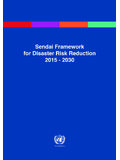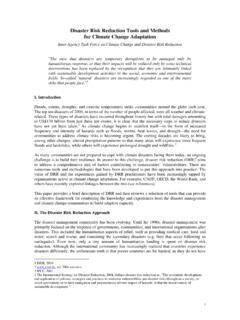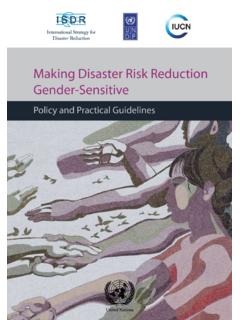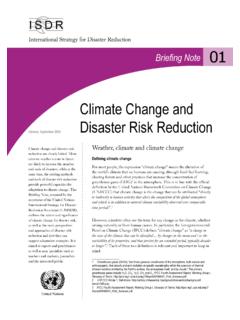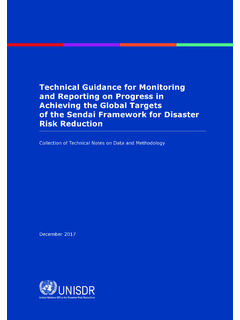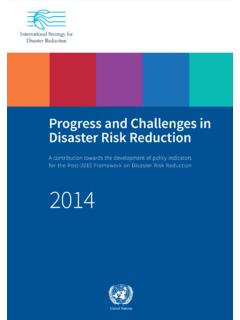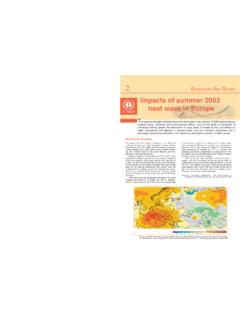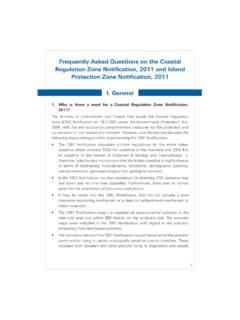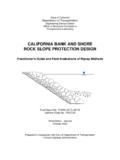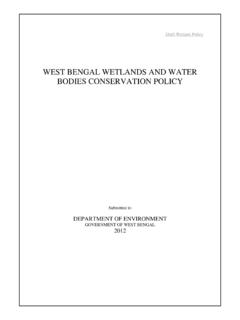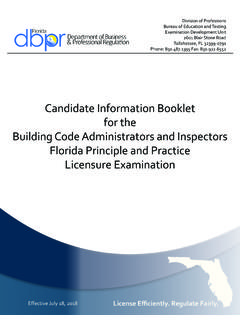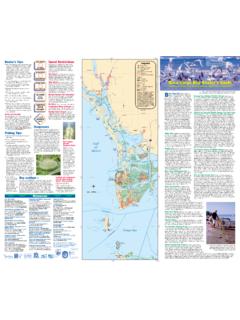Transcription of 7. Coastal Erosion Hazard and Risk Assessment - …
1 Words into Action Guidelines: National Disaster Risk Assessment Hazard Specific Risk Assessment 7. Coastal Erosion Hazard and Risk Assessment Key words: Coastal Erosion Hazard and risk Assessment , built environment, risk mitigationUNISDR 2017 1 Description of the Hazard , Sources and Setting Coastal Erosion (or shoreline retreat) is the loss of Coastal lands due to the net removal of sediments or bedrock from the shoreline. Erosion is typically driven by the action of waves and currents, and by mass wasting processes on slopes, and subsidence (particularly on muddy coasts). Significant episodes of Coastal Erosion are often associated with extreme weather events ( Coastal storms, storm surge and flooding) but also with tsunami, both because the waves and currents tend to have greater intensity, and because the associated storm surge or tsunami inundation may allow waves and currents to attack landforms that are normally out of their reach.
2 On Coastal headlands, such processes may lead to the undercutting of cliffs and steep slopes and contribute to mass wasting. In addition, heavy rainfall can enhance the saturation of soils, with high saturation leading to a reduction in the shear strength of the soil and a corresponding increase in the chance of slope failure. Coastal Erosion is a natural process that occurs whenever the transport of material away from the shoreline is not balanced by the deposition of new material onto the shoreline. Many Coastal landforms naturally undergo quasi-periodic cycles of Erosion and accretion on timescales of days to years this is especially evident on sandy landforms such as beaches, dunes, and intermittently closed and open lagoon entrances. However, human activities can also strongly influence the propensity of landforms to erode. For example, the construction of Coastal structures ( breakwaters, groynes ( Coastal barriers) and seawalls) can lead to changes in Coastal sediment transport pathways, resulting in Erosion in some areas and accretion in others.
3 The removal of sediments from the Coastal system ( 1by dredging, sand mining), or a reduction in the supply of sediments ( by the regulation of rivers) may also be associated with unintended Erosion . Cooper, A. and Pilkey (2012). Pitfalls of Shoreline Stabilization. Selected Case Studies. 1 Coastal Research Library 3, DOI Dordrecht : Springer Netherlands. 2 Shoreline retreat in the highly populated mega-deltas of Asia is partly attributed to regulation of rivers, reducing the sediment supply to the shoreline and associated deltaic plains, in addition to groundwater extraction, which has increased subsidence rates . On larger scales, natural and human-2induced climate change can modulate the likelihood and rate of Coastal Erosion . For example, mean sea level is predicted to increase in the coming decades/centuries due to anthropogenic climate change, and this is expected to increase the frequency of Coastal inundation events and thus opportunities for shoreline Erosion .
4 3 Coastal Erosion becomes a Hazard when society does not adapt to its effects on people, the built environment and infrastructure. Many human settlements are constructed in areas vulnerable to Coastal Erosion , with early estimates suggesting that around 70 per cent of the global coastline is eroding. But it is 4difficult to accurately quantify the global distribution of the Hazard and risk, since Coastal landforms and human settlements can vary significantly over spatial scales of metres to kilometres, and current global scale data sets are inadequate for assessments at this scale. National scale assessments 5highlight that there is considerable spatial variability in the risk at these fine scales. Queensland Government (2013). Coastal Hazard technical guide: Determining Coastal Hazard 2areas (last accessed 26 Jan. 2017 ) Intergovernmental Oceanographic Commission (2012).
5 Guide on adaptation options in Coastal 3areas for local decision makers: Guidance for decision making to cope with Coastal changes in West Africa. IOC Manual and Guide No. 62, ICAM Dossier No. 7 (last accessed 26 Jan. 2017 ) Bird, C. F. (1985). Coastline Changes. New York: John Department of Climate Change (2009). Climate Change risks to Australia s Coast: A First Pass 5 National Assessment . Department of Climate Change, Australia. Available from , last accessed 16 Feb. 2017) 3 Examples of Coastal Erosion Rapid: Storm surge: Australia has experienced a number of Coastal Erosion events, some dating from the 1800s. One of Australia s most damaging storms was the 1974 sequence, impacting Queensland and New South Wales. 6 Tsunami: The 2004 Indian Ocean Tsunami caused severe Coastal Erosion in a number of locations, including Thailand.
6 Impact was also observed on 7coral reefs, sea grass and mangroves. 8 Slow (sea-level rise): Happisburgh (United Kingdom), on Norfolk s North Sea coast, was once some distance from the sea. Historic records indicate that over 250m land was lost between 1600 and 1850. It is likely that the Norfolk cliffs have been eroding at the present rate for about the last 5,000 years when the sea level rose to within a metre or two of its present elevation. From most countries in the Pacific region there are many anecdotal reports that sea-level rise is already causing significant Erosion and loss of land. Evidence of Erosion includes beach scarps, undercutting of vegetation, including coconut palms, and outcrops of beach rock that have become uncovered by shoreline changes. The coastline of Tongatapu (Tonga) is subject to a range of Coastal protection studies and works.
7 The Ministry of Meteorology, Energy, Information, Disaster management, Climate Change and Communications has recognized the vulnerability of that coastline to Coastal Erosion processes, launching the Coastal protection Project in 2015. Hazard Assessment A wide range of methodologies have been applied for Coastal Erosion Hazard Assessment . The key factors influencing these methodologies include: The spatial and temporal scale of the analysis. This may range from an entire continent as part of a national Assessment to a regional analysis at local government level or a single sediment compartment to inform a particular Erosion issue. Callaghan, J. and P. Helman (2008). Severe storms on the east coast of Australia 1770-2008. 6 Griffith Centre for Coastal Management (last accessed 26 Jan. 2017 ) Choowong, M. and others (2007). Erosion and Deposition by the 2004 Indian Ocean Tsunami in 7 Phuket and Phang-nga Provinces, Thailand.
8 Journal of Coastal Research, vol. 23, issue 5, pp. 1270-1276. Thom, B. (2014) Coastal Compartments Project - Summary for policy makers. (last accessed 24 8 April 2017 ) 4 Likewise, the timescale of analysis can range from short-term (subannual) to better understand Coastal behaviour across the seasonal weather cycle or long-term (decadal) to incorporate climate variability and inform planning decisions. Geological timescales are also relevant on those coasts where sea-level rise is ongoing due to natural subsidence ( deltaic coasts such as in the Gulf of Mexico) or continued adjustments of land masses following deglaciation after the last ice age ( eastern Canada and northeastern United States). These natural changes across various timescales provide important context for understanding Coastal Erosion processes on short time scales and when making planning decisions (see figure 1 in [18]).
9 The timeline then 9defines the range of events that should be considered. For example, residential buildings in Australia (life of asset expected to be at least 50 years) are designed for events with an annual probability of exceedance of 1/500 (for wind and earthquake). The nature of the Coastal landforms and the offshore environment in the area of interest. At a general level, the form and composition of Coastal landforms and the presence of barrier islands and reefs in the offshore environment determines the sets of physical processes that should be considered in an Erosion Assessment . Sandy shorelines, Coastal cliffs, fringing reef coasts and deltaic coasts are each affected by somewhat different processes. The nature of the sea action being considered. The underlying driver for Erosion ( sea-level rise, storms or tsunami) will determine the types of analysis or modelling that will inform an Assessment .
10 In addition, future trends associated with climate change are critical and the event being considered ( design event (specified event possibly based on consequence or likelihood criteria) or extreme event (largest event believed possible) or the full range of events ( via a probabilistic analysis). Our understanding of the Coastal environment, and particularly how and where sediment is transported ( the sediment budget) will critically affect the appropriate choice of spatial scale for the study. Data availability place limitations on the nature of the Hazard Assessment (see table below for examples of input data for Hazard assessments). Coastal compartments represent one way to define the scales that should be considered when taking actions that could affect sediment budgets. For example, construction of a groynes may protect a community as intended but cut off sediment supply to another part of the same Coastal compartment, thereby leading to Coastal Erosion downdrift.)
